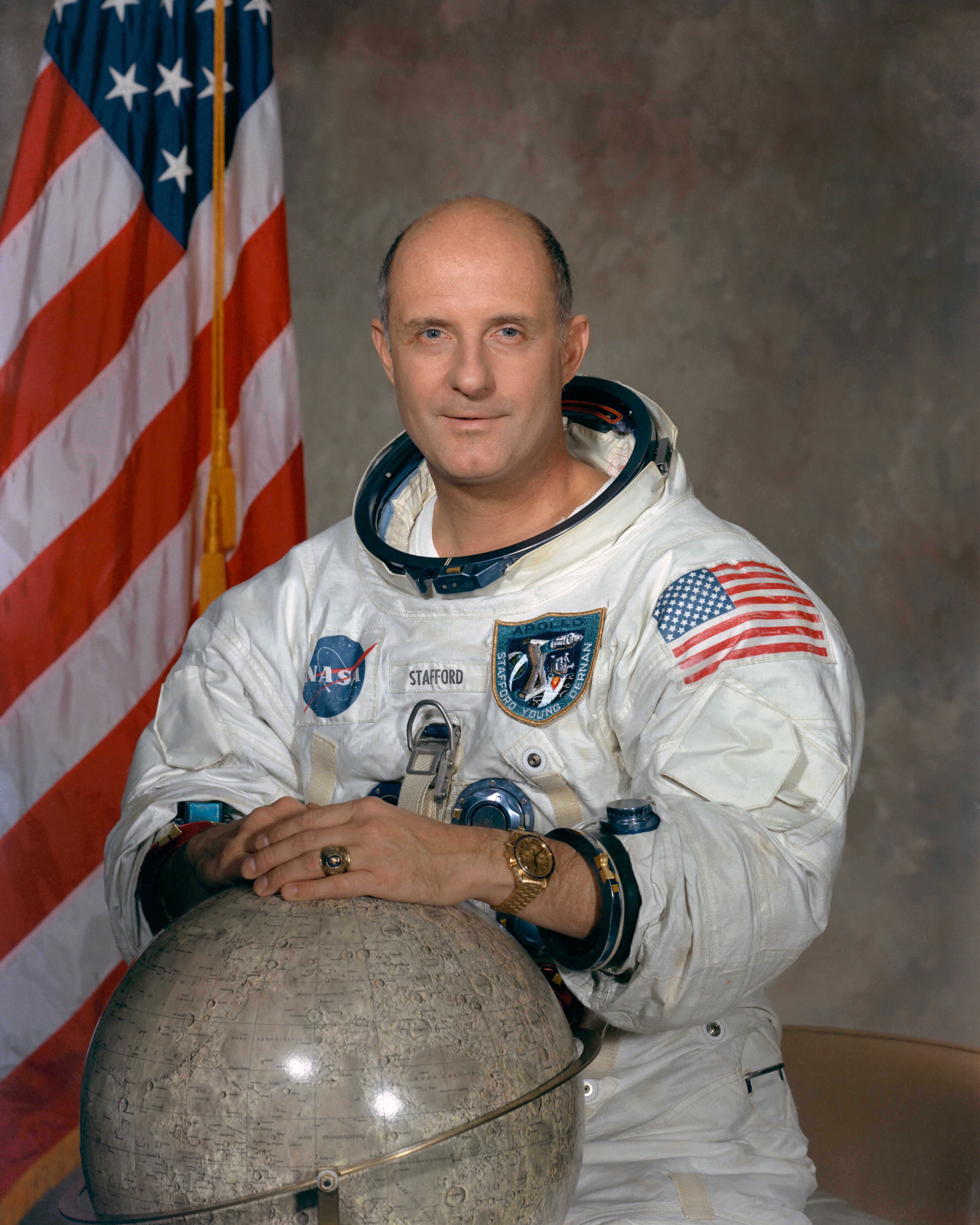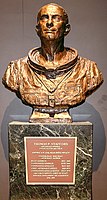
Thomas P. Stafford
Thomas Patten Stafford (September 17, 1930 – March 18, 2024) was an American Air Force officer, test pilot, and NASA astronaut, and one of 24 astronauts who flew to the Moon. He also served as Chief of the Astronaut Office from 1969 to 1971.
Thomas P. Stafford
After graduating from the United States Naval Academy, Stafford was commissioned in the United States Air Force, flying the F-86 Sabre before becoming a test pilot. He was selected to become an astronaut in 1962, and flew aboard Gemini 6A in 1965 and Gemini 9A in 1966. In 1969, he commanded Apollo 10, the second crewed mission to orbit the Moon. Here, he and Gene Cernan became the first to fly an Apollo Lunar Module in lunar orbit, descending to an altitude of nine miles.
In 1975, Stafford was the commander of the Apollo-Soyuz Test Project (ASTP) flight, the first joint U.S.-Soviet space mission. A brigadier general at the time, he became the first general officer to fly in space. He was the first member of his Naval Academy class to pin on the first, second, and third stars of a general officer. He made six rendezvous in space and logged 507 hours of space flight.
Stafford flew more than 120 types of fixed-wing and rotary aircraft and three types of spacecraft. After the deaths of Wally Schirra, Eugene Cernan, and John Young, he was the last surviving crew member of Gemini 6A, Gemini 9A, and Apollo 10.
In 1993, the Stafford Air & Space Museum was founded in his hometown of Weatherford, Oklahoma. Originally just two rooms, it has grown to over 63,000 square feet (5,850 m2) of artifact space. It is a Smithsonian affiliate and is the only museum in the world to house test-fired engines that would have been used in the Space Race: a U.S. F-1 engine and a Soviet NK-33 engine. It holds the Gemini 6 spacecraft that he and Schirra flew in a rendezvous with Gemini 7.
Early life and education[edit]
Thomas Patten Stafford was born on September 17, 1930, in Weatherford, Oklahoma, to Dr. Thomas Sabert Stafford, a dentist, and Mary Ellen Stafford (née Patten), a former teacher. Thomas Sabert Stafford was diagnosed with skin cancer in 1944, and died on June 22, 1948. Mary Stafford remained in Weatherford until her death in August 1987. Stafford became interested in aviation following the start of World War II, as the nearby city El Reno has an Army Air Corps training base. Stafford began making model airplanes, and made his first flight at the age of 14 in a Piper Cub. He attended Weatherford High School and graduated in 1948.[1]: 1–4, 219
In his senior year of high school, Stafford was recruited to play football at the University of Oklahoma, where he had received a Navy ROTC scholarship. Stafford applied to the United States Naval Academy, and was accepted to the Class of 1952. Stafford intended to play football for the Navy Midshipmen, but sustained a career-ending knee injury during a preseason practice session. After his freshman year, he sailed aboard the battleship USS Missouri, where his roommate was John Young, his future Apollo 10 command module pilot. After his second year, Stafford spent a summer at NAS Pensacola, where he was exposed to naval aviation and flew in the SNJ Trainer. On a trip home to Weatherford, Stafford began dating his future wife, Faye Shoemaker. After his third year, he served aboard USS Burdo, a destroyer escorting USS Missouri. While visiting home during his fourth year, Stafford became engaged to Faye in December 1951. In the spring of 1952, he was selected in a lottery to join the United States Air Force upon graduation.[note 1] Stafford graduated from the Naval Academy with a Bachelor of Science degree in engineering with honors in 1952, and was commissioned as a second lieutenant in the Air Force.[1]: 8–13 [2]
Military service[edit]
In high school, Stafford served in the 45th Infantry Division in the Oklahoma National Guard. Soon after, he transferred to the division's 158th Field Artillery Battalion, where he plotted targets for artillery fires.[1]: 6 [3]
Stafford attended the first phase of pilot training at Greenville AFB, Mississippi, San Marcos AFB, Texas and Connally AFB, Texas, where he flew the T-6 Texan and the T-33 Shooting Star. While on a training mission at San Marcos AFB, he was involved in a mid-air collision with another student pilot. Stafford and his instructor were able to land, but the other student pilot was killed. He graduated from pilot training on September 1, 1953, and moved to Tyndall AFB, Florida, for F-86 Sabre training. In 1954, Stafford was assigned to the 54th Fighter-Interceptor Squadron at Ellsworth AFB, South Dakota, where he flew the F-86 mission for Arctic defense. In 1955, Stafford transferred to the 496th Fighter Interceptor Squadron at Hahn Air Base (now Frankfurt-Hahn Airport), West Germany, again flying interceptor mission in the F-86 Sabre. In addition, he served as an assistant maintenance officer, developing his interest in applying for the USAF Experimental Flight Test Pilot School.[1]: 13–24
In 1958, Stafford attended the Air Force Test Pilot School at Edwards AFB, California, where he finished first in his class, and received the A. B. Honts Award. After graduation, he remained at Edwards AFB as a flight instructor. While working as an instructor, Stafford created the first civilian instructor position at Test Pilot School to ensure continuity, and co-wrote the Pilot's Handbook for Performance Flight Testing and the Aerodynamics Handbook for Performance Flight Testing.[4] At the end of his assignment, Stafford was accepted at Harvard Business School, and moved to Boston, Massachusetts, in September 1962. Three days after arriving, he was accepted to NASA Group Two.[1]: 27–38
Personal life and death[edit]
In 1953, Stafford married Faye Shoemaker from Weatherford, Oklahoma. Faye and Stafford had two daughters, Dionne (born 1954) and Karin (born 1957). Faye and Stafford divorced in 1985. Stafford later married Linda Ann Dishman in December 1988.[1]: 15, 19, 216, 219 They had two adopted sons, Michael Thomas and Stanislav "Stas" Patten.[4] Stafford enjoyed hunting, weight lifting, gliding, scuba diving, fishing and swimming.[4]
Stafford died from liver cancer at a care home in Satellite Beach, Florida, on March 18, 2024, at the age of 93.[18][19]
Throughout his career, Stafford received numerous awards for his accomplishments. He was a recipient of the American Institute of Aeronautics and Astronautics (AIAA) Award (1969), the Harmon International Aviation Trophy (1966), the National Academy of Television Arts and Sciences Special Trustees Award (1969), the Society of Experimental Test Pilots James H. Doolittle Award (1979) and the Elmer A. Sperry Award (2008). Stafford received recognition from the U.S. and Russian governments, with the U.S. Congressional Space Medal of Honor (1993) and the Russian Medal "For Merit in Space Exploration" (2011).[21][2][1][4]
Stafford's military decorations and awards include: the Air Force Distinguished Service Medal with two oak leaf clusters, Distinguished Flying Cross with oak leaf cluster, Air Force Commendation Medal and Air Force Outstanding Unit Award ribbon with three oak leaf clusters. Other awards presented to Stafford include: NASA Distinguished Service Medal with oak leaf cluster, NASA Exceptional Service Medal with oak leaf cluster,[22] the American Institute of Aeronautics and Astronautics Octave Chanute Award (1976), the Veterans of Foreign Wars National Space Award, the Golden Plate Award of the American Academy of Achievement (1976),[23] the National Geographic Society's General Thomas D. White USAF Space Trophy (1975),[24] and the A. B. Honts Award as the outstanding graduate from the USAF Experimental Test Pilot School.[1][4] He was awarded the Gold Space Medal from the Fédération Aéronautique Internationale (FAI) in 1976. FAI created an exception that allowed Leonov to be awarded it alongside him; typically the award is restricted to one person per year.[25] The RNASA Foundation awarded him with their highest honor, the National Space Trophy, in 1993.
In 2011, Stafford was awarded the National Aeronautic Association Wright Brothers Memorial Trophy, and the Air Force Association's Lifetime Achievement Award. He was elected to the National Academy of Engineering in 2014.[4] Stafford is an inductee of the National Aviation Hall of Fame, Oklahoma Aviation and Space Hall of Fame,[26] International Air & Space Hall of Fame, the U.S. Astronaut Hall of Fame,[27][28] and the International Space Hall of Fame.[29][20][30] He was a fellow of the American Astronautical Society, the American Institute of Aeronautics and Astronautics, the Society of Experimental Test Pilots, and a member of the Explorers Club.[31][4][32] In 2019, he was awarded the General James E. Hill Lifetime Space Achievement Award.[33]
Honoraria: Stafford was the recipient of a Doctorate of Science from Oklahoma City University; a Doctorate of Laws from Western State University; a Doctorate of Communications from Emerson College, and a Doctorate of Aeronautical Engineering from Embry-Riddle Aeronautical University.[4]
In his hometown of Weatherford, Stafford was honored with a building at Southwestern Oklahoma State University named in his honor, the Thomas P. Stafford Airport, and the Stafford Air & Space Museum.[34][35][36]
The Stafford Building at the Federal Aviation Administration (FAA) Mike Monroney Aeronautical Center in Oklahoma City is named after him.[37]
In September 2018, Stafford was depicted in a corn maze in Hydro, Oklahoma.[38]

